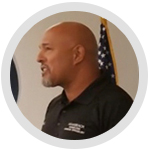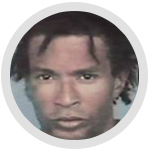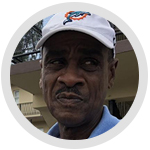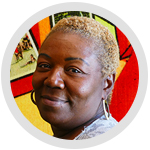Chronicle Cards
The Miami-Dade County Homeless Trust has created a curriculum designed to help our community understand the stories behind the headlines - they are called Chronicle Cards. Each story represents a unique individual’s experience with homelessness - many have happy endings, but unfortunately, some do not. Either way, we hope you will use these chronicles as a jumping off point to talk about ways you can help the Trust end homelessness in our great community! If you would like hard copies of these cards for your organization or classroom, email HADmiami@gmail.com.
 The Making Of A Real Hero
The Making Of A Real Hero
A graduate of Charles W. Flanagan High School in Pembroke Pines, Ashley decided she wanted to see the world. To do so, she decided to join the Navy.
Excited and proud to have been among the chosen to defend our country, she was just three weeks into training in Pensacola, FL when 9/11 happened. Ashley’s dream went from seeing the world, to just seeing the sea. For six months she was stationed on a Navy ship in the waters outside of Afghanistan, before being stationed stateside in California. Life was exciting. She fell in love, got married, had two children and received an honorable discharge. But when her marriage ended she returned home to Miami. She created her own catering business and was featured on The Housewives of New York.
Due to nagging injuries she sustained in the Military, her catering career came to an end. Her health got worse. She had a hard time holding down a job and raising the kids. Unfortunately, things were about to get worse for this veteran of war. An apartment above hers leaked causing irreparable damage. Using her savings, she moved to another apartment. While there, she fell ill and was taken to the hospital for two weeks. When she returned, she found there had been a leak in this new apartment that caused the growth of black mold. She had to move again. On her last dime, she went to a new apartment – it ended up being condemned. Ashley was homeless.
She thought about giving up her kids…it was all just too much to handle. She was terrified.
Living with her two children in her car, she put her pride aside and reached out to Operation Sacred Trust, a program operated by Purpose Built Family Foundations. This veteran homeless provider helped her get shelter, medical care and a job that she could do despite what turned out to be constant bouts of depression and seizures.
In 2014, Sacred Trust found her a condominium. She has since remarried, bought a new home and now has a one-year old baby. Today she is a poster-woman of sorts for homeless veterans, as she was asked to join U.S. Secretary of Housing and Urban Development, Ben Carson, at an event in August 2018, where the Miami-Dade County Homeless Trust announced the end of veteran homelessness.
 Breaking The “Concrete Animal”
Breaking The “Concrete Animal”
Once upon a time, Borinquen Hall says he was a “concrete animal,” roaming Miami Beach, dirty, drunk and high, accepting money from tourists and making beds out of park benches.
Known as “Bo,” he was born in Puerto Rico and raised on Miami Beach. At the age of 15, he was on his own, break dancing for money and beginning a downward spiral of drug use, alcohol abuse and a contentious “back and forth” with juvenile detention.
“I didn’t care about living or dying. I had been shot; in and out of the hospital for overdoses. I grew up fighting,” he remembers of his life as homeless on Washington Avenue, South Point, Miami Beach and Flamingo Park. For 10 years, he couch-surfed, stole, ate out of garbage cans, and got arrested for loitering, trespassing, panhandling and public drunkenness. “You know, all the homeless crimes.”
His street life came to a breaking point when one of his dearest friends, Greg Walder, died of an overdose. It wasn’t the first friend he lost from an overdose, but it was his closest. The grief sent Bo on a cocaine-heroin binge for weeks that left him waking up on the shore, near death himself.
Bo ended up Jackson Memorial Hospital with another chance. Not long after, he joined some friends at Calvary Chapel in Miami Beach, where he met Georgia and Frank Gittinghart, a couple who gave him support and encouraged him to get help. Georgia and Frank eventually took Bo to the Miami Rescue Mission. “They brought God into my life,” he said.
Bo lived at the shelter for three years, describing it as the best decision he ever made. He had reconstructive surgery to fix a giant hole in his nose that was the result of intense and long-term cocaine use. His mouth full of cemented gold teeth were removed and replaced with veneers. Most importantly, he began studying to become an EMT paramedic and started working for the Miami Beach Homeless Outreach program.
This year, Bo was hired as a Homeless Liaison Specialist with Miami Beach Police. He is one of only a handful of civilians in the US working with a police unit and representing homeless residents who suffer from severe mental illness, substance abuse, medical conditions and alcoholism. He’s a regular presence before County judges advocating through the Marchman Act for those who refuse help, yet present symptoms that indicate they are a danger to themselves or others.
“I have worked with thousands of homeless individuals to get them off the streets. I can help these people because they relate to me. I’m a living example that recovery can happen. I know this could have been me, if not for so many people who have walked with me on this journey.
A Life Spent Recovering
Michael Barker has spent his life in recovery. At Clemson University, he tore his ACL, cutting short a promising soccer career. He recovered by joining the U.S. Army. During an Army training exercise, while running with another man in his arms, he stepped into a three-foot-hole and ruptured his spine. He recovered.
A month later, while on another mission, he jumped out of an airplane. His colleague’s parachute didn’t open. To save him, Michael wrapped his arms around his comrade. When the parachute finally opened up, he felt a pop in his spine from top to bottom, "like a row of dominoes,” he recalls. He was paralyzed for three days after surgery. While he was discharged from the military with honors for his bravery, Michael left with a problem.
He was hooked on pain killers. Morphine, fentanyl, oxytocin and oxycodone put him in a “zombie state” that followed him back to school, when he returned to study recording arts. Michael left school again, at 28 years old, because he “couldn’t think, couldn’t function. Like the fighter he was, he again recovered and started a career as a DJ, moved to South Carolina, got married and coped with chronic, debilitating pain. Another surgery to fix his spine left him paralyzed from the waist-down, fighting death and hospitalized for six months. When he emerged, he was an addict.
"I never, ever thought I would put a needle in my arm, but there I was – addicted,” he said. He upped the ante, using meth and heroin. Eventually, he and wife, who was also addicted, lived homeless in his car for three long years. After being arrested for possession of heroin, Michael moved to Florida for treatment in 2017.
Eight years later – after many failed attempts – Michael and his wife completed their final recovery and are living at Karis Village, an affordable housing community developed by Carrfour Supportive Housing. Approximately half of Karis Village is set aside for at-risk veterans. The couple is expecting their first child in 2019, and Michael’s sober date lands fittingly on Veterans’ Day.
“I think if I could get into the recovery field, I could help a lot of people,” said Michael, who at 93 percent disabled, is hoping to follow his passion for music and education. After the baby comes, he will be touring as an EDM DJ and also working towards his degree in psychology from the University of Miami.
 He Wanted To Create Superheroes
He Wanted To Create Superheroes
Norris Gaynor was just like any other kid. When he was young, he and his brother, Russell, dreamt of creating a superhero series. Norris sketched the characters, and Russell thought up their powers.
They played as boys do, fighting the good fight with their Batman and Superman figurines. Norris was one of three boys; his other brother, Jerome, died of cancer at seven years old.
Media reports were unsuccessful in filling in the gaps between his childhood and his life on the streets, which took a tragic turn while he was trying to sleep.
Norris was only 45 years old when inebriated South Florida teenagers Thomas Daugherty, Brian Hooks and William Ammons decided to “beat up bums” for fun in Fort Lauderdale. Gaynor was one of three homeless men attacked but the only one to perish. During an early-morning assault on Jan. 12, 2006, he was clubbed to death with a baseball bat and a rake. His assailants were convicted of second-degree and third-degree murder.
With the loss of his brother, Russell re-dedicated himself to seeing their childhood dream come true. He was working to self-publish a fantasy role-playing game and novel, based on superhero characters he and Norris created as children.
The Homeless Trust also found a way to remember Norris. Following his tragic death, the Homeless Trust launched a poster and essay contest in his honor for public school students to help them think about the issue of homelessness, combat bullying of the homeless and lay the foundation for a more compassionate community. That poster contest continues to this day, and every year when winners are announced, the Homeless Trust Board takes time to remember this poignant point in South Florida history.
When Norris died, attacks against the homeless were on the rise, nationwide nearly doubling from 1999 to 2003. From 2000 to 2006, at least 156 homeless people were murdered, according to the National Coalition for the Homeless (NCH). Most of the assailants were young men in their teens to early 20s.
By 2016, violence against homeless people was on the decline in the U.S., but the nature of such crimes hadn’t changed much, according to an NCH report. In 2015, NCH reported there were 77 reported attacks against homeless people, down from 122 victims in 2014. While the drop was bolstering news, advocates said that the crimes were just as heinous as ever. Homeless residents were burned alive, drowned or beaten to death.
"In many of the cases, it's a crime of opportunity," said Michael Stoops, the coalition's acting executive director who was quoted by NPR after Norris’ murder in 2006.
"A group of teenagers is roaming the street on a hot summer night and they come across a homeless person who might be mentally ill or alcoholic. When they hurt a homeless person, they think they can get away with it -- and they think they won't be hurt in return."
Online Resources:
 It Took An Entire Year
It Took An Entire Year
Olga Salfran was stubborn, as are many people who make their peace with being homeless.
Even though she was educated as a nurse in her home of Santiago, Cuba, and had worked in a maternity hospital before coming to America, Olga refused necessary medical treatment for her mental illness. Even though her husband, who had once braved the streets with her, had died after being hit in the head while living exposed and vulnerable to attack, she ignored offers of shelter. And even though she had a grown son, living somewhere in the U.S., she remained disconnected from him for more than eight years.
Persistence drove a team of professionals in a program called the Lazarus Project to keep checking on Olga in 2015, week after week, even though she cursed them, turning down every offer of assistance. Until one day, she began to talk to them. She let them know that she might someday want a place to stay.
An entire year would pass before she accepted help. When she did, Olga was placed directly into Cedar’s Court apartments at Camillus House, an organization that provides a full-range of services to support the Homeless. She began taking her medication, grocery shopping, caring for herself and sharing her journey.
In Cuba, she had two sons, Joseph and Joel; but, the oldest, Joseph, would die of cancer at only 10 years old. That’s when her depression began. In 1999, she, her husband and Joel won the visa raffle to come to the U.S. Once in Miami, she found work as a hotel housekeeper and at a local grocery store. For years, she and her husband lived in a trailer park. Eventually, their son grew up and moved away; and after some time, unbeknownst to him, his parents moved into their car. They lived behind the grocery store, until Olga’s husband was attacked and their car was repossessed with all of her belongings in it.
Once her life was redirected, Olga became brand new – inside and out. Inside, her heart was healed through reconnection with Joel and his family. She was a grandmother! Outside, she received a beauty makeover and was featured on local TV with new clothes, makeup and hair. Thanks to the Lazarus Project, Olga was reborn.
 His Nickname Was “6-9”
His Nickname Was “6-9”
Ronnie Valentine was hard to miss, on and off the basketball courts. A towering figure at nearly 7’, he became a star high school and college player, known for his 3-point shots. At Old Dominion University, he was the first Division I player to score double figures more than 100 games in a row. Soon, he was being celebrated in the NBA, playing for the Denver Nuggets, then in minor and foreign leagues.
However, in 1980, things changed. When a teammate introduced him to drugs, Ronnie went from making headlines to doing lines. His life began to spiral out of control with financial troubles and personal crises. Then, 10 years later, he disappeared.
Virginian Pilot reporter Harry Minium, who had covered Ronnie’s career when he was a young sports writer, started asking around, wondering what had happened. In 2018, he partnered with Ronnie’s friend from Old Dominion, Wes Lockard, who lived in South Florida and happened to be the former mascot for The Miami Heat. Together, they crisscrossed some of the roughest, most depressed and dilapidated parts of Miami to find him.
After a multi-day search that was aided by the media relations director at Camillus House, they found 61-year-old Ronnie, affectionately nicknamed “6-9” for his distinctive height. Decades after being homeless and addicted to drugs, he was in supportive housing in Liberty City, figuring out how to live clean. Phone calls connected him to former coaches and teammates who had never forgotten him. Harry shared the emotional story.
 In A Matter Of Minutes, He Was Gone
In A Matter Of Minutes, He Was Gone
Thomas Muloni was not "chronically homeless." He would periodically receive help from organizations like The Homeless Trust, Salvation Army and Camillus House, before setting out to parts unknown.
In 2013, Thomas was registered as a student at Full Sail University in Orlando. By 2015, he was 30 years old and sleeping along the Miami River. What happened during those two years, no one really knows, but a few random facts were gathered about him:
He was born in Africa. He was arrested once in Orange County in 2012 for trespassing. And he had friends. Those friends, also homeless, stood by helpless as Thomas had an altercation with a local teenager – an altercation that would change both of their lives.
Described by his father as “a good kid who was working out some issues,” Rhyheim Shadrach Woodard was 16 years old when he roused a homeless man awake, looking for fishing bait. Witnesses reported that Rhyheim grabbed Thomas Muloni’s hat and tossed it into the water. When Thomas stood up to confront him, Rhyheim pushed him to the Miami River, grabbed Thomas’ belongings and rode off on his bike.
Thomas couldn’t swim, and in a matter of minutes, he was gone. The following night, his body was recovered, floating three blocks away on the river bank. Rhyheim was later identified, arrested and charged as an adult with second-degree murder.
“This is an ugly crime of violence,” said then Miami-Dade State Attorney spokesman Ed Griffith.
In 2016, Rhyheim was sentenced to prison with a release date of 2022.
 Finding Her True Worth
Finding Her True Worth
“When I was a baby, my mother sold me for $500.”
Velicia Bryant’s start in life was marked by one terror after another. Her teenage mother, whom she would never meet, sold her to an aunt and uncle. Her earliest memories were of sexual and physical abuse at the hands male uncles and cousins. Her aunt beat her when she tried to speak up. She suffered unmeasurable pain – both emotional and physical.
After 16 years of molestation, rape and beatings, she ran away from her Maryland home. She got as far as Philadelphia, where she survived by selling herself. Eventually, she was sent back home, only to escape again by marrying a young man from her church. She was 17.
But the terrors didn’t stop. Haunted by the pain of her childhood, Velicia couldn’t find the peace to enjoy her new life and family of five children. Instead, she filled the emptiness and insecurity with drugs, running away once more; this time, she ran as far as Miami and began life on the streets.
Velicia lived for decades in a pattern of self-loathing and self-destruction before attempting the ultimate escape, suicide. After taking a bottle of pills, she was rushed to Jackson Memorial. The doctor who saved her life told her, “I see something in you. You don’t have to go back out there.”
That’s how Velicia came to be part of Project Phoenix, a special program at Camillus House to provide healing, housing and new hope to victims of human trafficking. It didn’t take long for Project Phoenix to impact her life. “When I arrived, one of the residential assistants, Alina, came up to me. When she reached out and hugged me, something came over me. I felt safe and I just broke down and cried. I knew everything was going to be ok.”
Now, through Camillus House, she has her own apartment and is working for the Miami Downtown Development Authority, earning her GED, and receiving therapy, life skills training and vocational development. Finally discovering her true value, she started the “Shoes of Mercy” initiative, which encourages women victimized by human trafficking to tell their stories with white canvas shoes. The women use magic markers to write and draw on the shoes in all colors. Their markings are a record both of where they’ve been, and like Velicia, where they are going.
Learn more about Velicia’s story here:
- Sold at birth,Velicia finds new hope after a half century of suffering
- New Hope For Victims Of Human Trafficking & Sex Slavery
According to recent media reports, The Florida Department of Children and Families counted nearly 1,900 reports of human trafficking statewide in 2016, a 54 percent increase from the previous year. Advocates for victims have called human trafficking modern-day slavery. Under state and federal law, it is defined as soliciting, recruiting, harboring, transporting or otherwise obtaining another person to exploit him or her for labor, domestic servitude or sexual exploitation.
According to the Polaris Project – a nonprofit based in Washington, D.C. that tracks the number of calls to the national trafficking hotline – Florida had the third-highest number of reported cases in 2016, behind only California and Texas.
